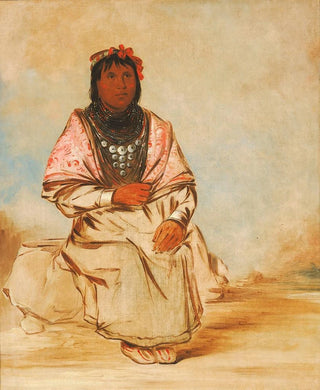Art print | A Seminole woman - George Catlin


View from behind

Frame (optional)
In the fascinating world of 19th-century American art, the art print "Une femme séminole" by George Catlin stands out for its depth and sensitivity. This depiction of a woman belonging to the Seminole tribe is not just a simple portrait; it reflects a rich and complex culture and offers a window into a often little-known world. Catlin, as an artist, committed himself to immortalizing the traditions and lifestyles of indigenous peoples, and this work is a poignant testament to that dedication. The beauty of the Seminole woman, captured with remarkable precision, evokes both the strength and delicacy of her cultural identity.
Style and uniqueness of the work
Catlin's style is characterized by meticulous attention to detail and a vibrant color palette that breathes new life into his subjects. In "Une femme séminole," the composition is carefully balanced, highlighting the graceful posture of the woman while integrating elements of her environment. The traditional motifs of her clothing, as well as the accessories surrounding her, are rendered with such finesse that they tell a story in their own right. The artist manages to capture not only the external appearance of his subject but also the very essence of her culture, creating a work that transcends time. This immersive approach allows the viewer to resonate with the emotions and stories hidden behind the face of the Seminole woman.
The artist and his influence
George Catlin, born in 1796, is often considered one of the first artists to document Native American cultures with such passion and dedication. Traveling across the United States, he created numerous works that testify to the diversity and richness of indigenous traditions. His work is much more than a simple collection of portraits; it is an act of preservation, an attempt to safeguard lifestyles threatened by colonial expansion. Catlin's impact on art and history is undeniable, as he paved the way for a new understanding of these cultures within American society. His works continue to inspire

Matte finish

View from behind

Frame (optional)
In the fascinating world of 19th-century American art, the art print "Une femme séminole" by George Catlin stands out for its depth and sensitivity. This depiction of a woman belonging to the Seminole tribe is not just a simple portrait; it reflects a rich and complex culture and offers a window into a often little-known world. Catlin, as an artist, committed himself to immortalizing the traditions and lifestyles of indigenous peoples, and this work is a poignant testament to that dedication. The beauty of the Seminole woman, captured with remarkable precision, evokes both the strength and delicacy of her cultural identity.
Style and uniqueness of the work
Catlin's style is characterized by meticulous attention to detail and a vibrant color palette that breathes new life into his subjects. In "Une femme séminole," the composition is carefully balanced, highlighting the graceful posture of the woman while integrating elements of her environment. The traditional motifs of her clothing, as well as the accessories surrounding her, are rendered with such finesse that they tell a story in their own right. The artist manages to capture not only the external appearance of his subject but also the very essence of her culture, creating a work that transcends time. This immersive approach allows the viewer to resonate with the emotions and stories hidden behind the face of the Seminole woman.
The artist and his influence
George Catlin, born in 1796, is often considered one of the first artists to document Native American cultures with such passion and dedication. Traveling across the United States, he created numerous works that testify to the diversity and richness of indigenous traditions. His work is much more than a simple collection of portraits; it is an act of preservation, an attempt to safeguard lifestyles threatened by colonial expansion. Catlin's impact on art and history is undeniable, as he paved the way for a new understanding of these cultures within American society. His works continue to inspire






